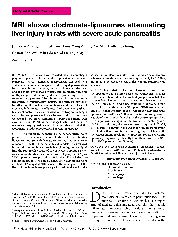摘要
BACKGROUND: Studies have revealed that macrophages play an important role in the development of severe acute pancreatitis (SAP). Activated macrophages can lead to a systemic inflammatory response, induce lipid peroxidation, impair membrane structure, result in injury to the liver and the other extrahepatic organs, and eventually result in multiple organ dysfunction syndrome by promoting excessive secretion of cytokines. Liver injury can further aggravate the systemic inflammatory response and increase mortality by affecting the metabolism of toxins and the release of excessive inflammatory mediators. Clodronate is a synthetic bisphosphonate, which is often used for treating bone changes caused by osteoporosis and other factors. In the current study, we created liposomes containing superparamagnetic iron oxide particles (SPIOs) for macrophage labeling and magnetic resonance imaging, using a novel method that can bind the clodronate to induce apoptosis and deplete macrophages. METHODS: Superparamagnetic Fe3O4 nanoparticles were prepared by chemical coprecipitation. SPIO-containing liposomes and SPIO-clodronate-containing liposomes were prepared by the thin film method. SAP models were prepared by injection of sodium taurocholate (2 ml/kg body weight) into the subcapsular space of the pancreas. Sprague-Dawley rats were randomly divided into a control group, a SAP plus SPIO-liposome group, and a SAP plus SPIO-clodronate-containing group. Two and six hours after SAP models were available, T2-weighted MRI scans (in the same plane) of the livers of rats in each group were performed. At the end of the scans, 2 ml of blood was taken from the superior mesenteric vein to measure the levels of serum amylase, ALT, AST, TNF-alpha, and IL-6. Pathological changes in the liver and pancreas were assessed. RESULTS: Transmission electron microscopy showed that the liposomes had a uniform size. No pathological changes in the pancreata of rats in the control group were noted. The pathological changes in the pancreata and livers of rats in the SAP plus SPIO-clodronate-containing liposome group were milder than those in the SAP plus SPIO-liposome group. The MRI signal intensity of the livers in the SAP plus SPIO-liposome and SAP plus SPIO-clodronate-containing groups was significantly lower than that in the control group. There were significant changes in the two experimental groups (P<0.01). In addition, the levels of serum amylase, ALT, AST, TNF-alpha, and IL-6 in rats in the SAP plus SPIO-liposome group were higher than those in the control group (P<0.01), while the corresponding levels in the SPIO-clodronate-containing liposome group were significantly lower than those in the SAP plus SPIO-liposome group (P<0.01). CONCLUSION: Clodronate-containing liposomes protect against liver injury in SAP rats, and SPIO can be used as a tracer for MRI examination following liver injury in SAP rats. (Hepatobiliary Pancreat Dis Int 2010; 9: 192-200)
- 出版日期2010-4
- 单位江苏大学
